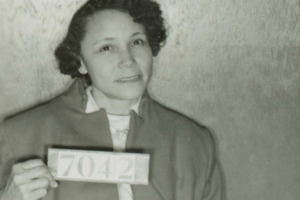 Excerpt from National Museum of African American History & Culture
Excerpt from National Museum of African American History & Culture
Born on April 17, 1912, in Culloden, Georgia, Robinson distinguished herself early as the valedictorian of her high school class, went on to become the first person in her family to graduate from college, and then fulfilled her dream of becoming a teacher.
She taught in the Macon, Georgia, public schools for five years while earning a master’s degree from Atlanta University. She also pursued English studies at Columbia University in New York City. She moved to Montgomery in 1949 to teach at Alabama State College.
In Montgomery, she became active in the Women’s Political Council (WPC), a local civic organization for African American professional women that was dedicated to fostering women’s involvement in civic affairs, increasing voter registration in the city’s black community, and aiding women who were victims of rape of assault.
Soon after arriving in Montgomery, Robinson was verbally attacked by a public bus driver for sitting in the “whites only” section of the bus. When she became the WPC’s president the following year, she made desegregating the city’s buses one of the organization’s top priorities.
The WPC repeatedly complained to the Montgomery city leaders about unfair seating practices and abusive driver conduct. But the group’s concerns were dismissed, leading Robinson to begin laying plans for a bus boycott by the city’s African American community. Following Rosa Park’s arrest in December 1955 for refusing to give up her bus seat to a white person, Robinson and a few associates jumped into action. They copied tens of thousands of leaflets and distributed them across the city, calling for a one-day boycott.
Following the overwhelming success of the one-day boycott, Montgomery’s black citizens decided to continue the campaign, establishing the Montgomery Improvement Association (MIA) to organize the effort and electing Dr. Martin Luther King Jr. as the MIA’s president.
Robinson chose not to accept an official MIA position for fear of jeopardizing her job at Alabama State, but she worked behind the scenes as a member of the MIA’s executive board, wrote and edited the MIA weekly newsletter, and volunteered in the carpool system that helped African Americans get to and from work.
In his memoir of the boycott, Stride Toward Freedom, Dr. King said of Robinson, “Apparently indefatigable, she, perhaps more than any other person, was active on every level of the protest.”
Despite Robinson’s efforts to stay out of the limelight, she was among a group of boycott leaders arrested but never tried. She was also targeted with several acts of intimidation. One local police officer threw a stone through her window, and another poured acid on her car. Eventually, Alabama’s governor ordered the state police to guard the homes of Robinson and other boycott leaders.
The boycott continued until December 20, 1956, when the U.S. Supreme Court declared segregated seating on buses unconstitutional.
The Montgomery Bus Boycott was one of the first successful protest of segregation in the Deep South, inspiring other nonviolent civil rights protest. It also established Dr. King as a prominent national figure. Robinson was especially proud of the role that women played in boycott’s success, saying:
Women’s leadership was no less important to the development of the Montgomery Bus Boycott than was the male and minister-dominated leadership.
In a 1976 interview, Robinson pointed out, “That boycott was not supported by a few people; it was supported by 52,000 people.”
After the boycott victory Robinson continued to teach at Alabama State until 1960, when she and other faculty supporters of student sit-ins at the college resigned. She went on to teach at Grambling College in Louisiana, then moved to Los Angeles, where she taught in the public school system until her retirement in 1976.
Her memoir, The Montgomery Bus Boycott and the Women Who Started It, was published in 1987. In it she expressed her great pride in the boycott’s success. She remained actively involved in her community and in local politics until her death in Los Angeles on August 29, 1992.
